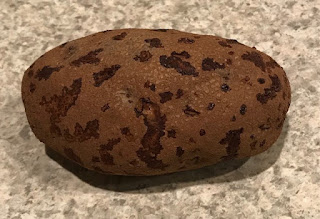 |
| Mid-February harvest |
After my Yukon crop had been such a bust this year—terrible scab and insect damage—you’d think I would have been highly motivated to give my russets better treatment. Especially since I’d learned that in our garden, the variety has proved to be much more resilient than Yukons.
Through the fall and into winter, as the rains poured down, the snow arrived, and we had record breaking low temperatures, I never got around to harvesting the bed. I’d gaze at it out the “great room” windows (kitchen/living/ dining room), feeling the potatoes reproaching me.
My conclusion: the taters had likely rotted in the ground. So no way would I get any decent potatoes out of that mess.
And I hate waste. I’d wasted the money we spent on potato seed, wasted the time and energy I’d put into planting and tending. Wasted all that food. But as much as I wanted to, I couldn’t turn back the clock.
And the russet bed, since it had to be full of rotten potatoes, was the priority—since nothing could be planted in there until I got the yucky stuff out.
And what do you know, six medium brown ovals appeared: russet potatoes!
Apparently the super-hard freeze we’d had at Christmas and the week after hadn’t extended eight inches below the surface, where the potatoes were. And maybe the foot of snow on top of the bed, which had taken most of January to melt, had kept the soil from freezing that deep as well.
I proceeded to turn up the rest of the hills—and found a healthy yield with each one. Lots of little guys, but some good-sized spuds too, perfect for baking. The proof, though, would not be in the pudding—it would be after I hosed these puppies down.
So I gently piled the spuds in my little plastic basket/sieve, got out the sprayer and turned the hose on the taters, rolling them in the basket to make sure every potato got rinsed. It was dark by now, and my mittens were soaked—time to quit for the night.
After an hour and 10 minutes at 370 degrees, I pulled them out. The baked potatoes were covered with these weird spots. But other than that, they seemed okay.
 |
| Weird spots close-up |
Cut open, and the insides fork-mashed with butter, the spuds were actually tasty! The spots had had no impact. My guess is, that long storage time in very cold soil—colder than refrigeration—had turned much of the starch in the potatoes to sugars. So the sugars leaked from the piercings and maybe through the skin too.
No comments:
Post a Comment